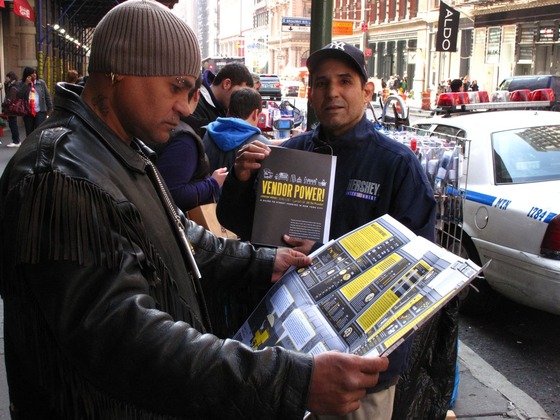Preparing a Values Guide to Evaluating Arts & Social Change and Aesthetic Characteristics for Social Justice-Oriented Art.
By Pam Korza.
At the October Grantmakers in the Arts (GIA) conference, artist Rosten Woo described the Vendor Power! project, a poster/brochure initiated by the Center for Urban Pedagogy (CUP) and designed by artist Candy Chang to make comprehensible New York City’s most commonly violated street vending rules which are buried in hundreds of pages of impenetrable bureaucratese. For thousands of vendors whose first language is not English, the Vendor Power! poster became an essential tool, directly helping them to understand their rights, avoid fines, and know how to respond when approached by police. Woo reported with satisfaction that, following CUP’s distribution of 10,000 posters, the Dept. of Consumer Affairs seized the poster’s power to address a longstanding institutional problem and printed another 10,000. Here the system took action to change a problematic practice. If only evidence of change was always so clear!
At GIA, Animating Democracy, a program of Americans for the Arts, was joined by partners, the Arts x Culture X Social Justice Network, and the Nathan Cummings Foundation and 70 kindred spirits who participated in our Evaluation Test Kitchen session and offered feedback on two in-progress frameworks evolving out of the Evaluation Learning Lab.
One framework they tested was the Values Guide to Evaluating Arts & Social Change. It addresses the fact that common evaluation can fall short of being relevant, ethical, equitable, and realistic when it comes to assessing arts and social justice work. It proffers a set of values (congruent with the nature of the work itself) that should guide evaluation design and implementation—reciprocity, shared learning and understanding, context, equity, appropriate metrics, and right-sized expectations, among others—as well as related indicators of responsible evaluation.
The second is a framework of Aesthetic Characteristics for Social Justice-Oriented Art (see also Chris Dwyer’s blog on Searching for a Framework to Describe Quality) that addresses the challenge that conventional aesthetic standards are not always well suited to discuss and assess the aesthetic/artistic qualities of arts and social change work. The Test Kitchen served up artistic qualities that are important in effective arts and social justice work. Stickiness, for one, is about memorable aesthetic take-aways, i.e. to influence social change, art inspires people over time and repeatedly. The Vendor Power poster has a stickiness factor! Other aesthetic qualities include: disruption, authenticity, communal meaning, porosity, risk-taking, emotional response, and sensory experience. The framework describes each quality’s meaning, importance in relation to social justice, as well as questions that can help grant panelists and other sector partners assess if and how effectively that quality is present in the work. Both frameworks received useful critique and general appreciation and we still welcome feedback from anyone inclined to dig in (see below).
We invite feedback through our ELL Framework Feedback Call that ACSJN is hosting on the two draft frameworks.
-
A Framework of Aesthetic Characteristics and questions to help assess aesthetic process and product/experience of art, culture and social justice work.
-
A Framework of Values and related questions to help arts practitioners, evaluators, and funders plan and implement responsible and ethical evaluation and be intentional about evaluation practices that reflect values congruent with social justice.
Sign up for our December 1st ELL Framework Feedback Call. Find complete details here.
This blog is a revision of a previous blog post for the Americans for the Arts Blog.

Leave a Reply